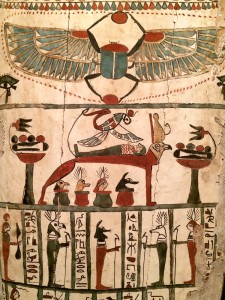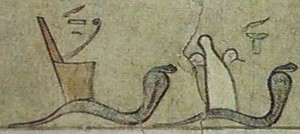There is always news about artifacts of Ancient Egypt. Now it is the turn of the coffin of “Denit-Ast”. It dates from the Persian Period and it is in the Toronto’s Royal Ontario Museum.
As Gayle Gibson exposed, this coffin has many oddities in its decoration, which could be a proof of the lack of god masters in Egyptian art during this period of the Ancient Egyptian history.

Coffin of Denit-Aset from Persian Period. Torontos Royal Ontario Museum.
I would like just to make some reflections on the icon of the snake flying over the corpse. It is a winged cobra with two horns and a solar disk on the head. As Gibson says, this crown is usually associated with the ancient Egyptian goddess Hathor. But makes sense an hathoric crown here? Could we think on an association of this icon with the goddess Isis?
If we focus on the three main “anomalities” of this crowned flying snake maybe we could better understand this image:
1) The winged element over the dead is very common in the funerary iconography of Ancient Egypt. It is ususal to depict a bird over the mummy, which sometimes is identified with the ba bird, but it is also an image of Isis over the dead body of Osiris. According to the belief of Ancient Egypt Isis adopted the shape of a kite for reviving the mummy of Osiris.
On one hand, by flapping her wings, Isis made the necessary air for giving the breath of life to Osiris. On the other hand, she put over the phallus of her husband for giving him back his virility; There are many examples in the art of Ancient Egypt where we can see the kite over the corpse proceeding to a sexual stimulation: the ushabti of Pay, the statuette of Prince Tutmosis, a relief in the temple of Seti I in Abydos…

Coffin of Denit-Aset from Persian Period. Isis over the mummy. Torontos Royal Ontario Museum
2) The snake is also an image related in Ancient Egypt to the two mourners of Osiris (the dead), Isis and Nephtys. Specially from the New kingdom it was usual to depict these two goddesses in the eleven hour of the Book of the Amdouat as cobras wearing the crowns of Lower and Upper Egypt.

Isis and Nephtys llike cobras in the eleven hour of Te Book of the Amduat. Tomb of Amenhotep III. XVIII Dynasty.
3) The hathoric crown is also a common element in the images of Isis from new Kingdom on. Due to the assimilation in Ancient Egypt of Isis to Hathor, it became normal to depict Isis with the crown composed of the two horns and the disk.
Considering these three points, we could think that the winged snake with the hathoric crown over the corpse of Denit-Aset was an image of goddess Isis, the mourner which over the dead body restored the vital faculties to the mummy.